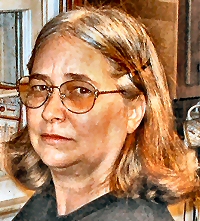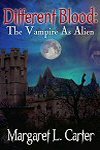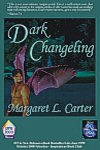by Margaret L. Carter
 I’ve been a lifelong fan of “good guy” vampires, even back when they were almost impossible to find except in a few short stories. The classic vampire, a supernatural undead creature, was traditionally assumed to be animated by the Devil and therefore intrinsically evil.
I’ve been a lifelong fan of “good guy” vampires, even back when they were almost impossible to find except in a few short stories. The classic vampire, a supernatural undead creature, was traditionally assumed to be animated by the Devil and therefore intrinsically evil.
Personally, I always disliked the premise that a character instantly lost individual personality and free will upon transformation into one of the undead. This assumption was gradually subverted in the 1960s and 70s by supernatural vampires who struggled against their curse (e.g., Barnabas in DARK SHADOWS) or weren’t diabolical to begin with (e.g., Chelsea Quinn Yarbro’s Count Saint-Germain). For an especially fruitful approach to the ethical vampire, however, consider him or her as a member of another humanoid species.
 If this creature has evolved as a part of nature, he or she can’t be innately evil, any more than a human character would be. The natural, morally neutral vampire can make ethical choices on the same basis as any other sapient being. Vampires as “aliens,” in the sense of another species, whether terrestrial or extraterrestrial, have existed in fiction throughout the twentieth century and even a bit earlier. (I discuss a plethora of them in my book DIFFERENT BLOOD: THE VAMPIRE AS ALIEN from Amber Quill Press, www.amberquill.com.) My first book, an anthology called CURSE OF THE UNDEAD (1970), included a vampire-as-extraterrestrial story written by my husband, “Vanishing Breed,” on which my vampire series was ultimately based. Novel-length examples of the subgenre, however, began to flourish after the late 1970s.
If this creature has evolved as a part of nature, he or she can’t be innately evil, any more than a human character would be. The natural, morally neutral vampire can make ethical choices on the same basis as any other sapient being. Vampires as “aliens,” in the sense of another species, whether terrestrial or extraterrestrial, have existed in fiction throughout the twentieth century and even a bit earlier. (I discuss a plethora of them in my book DIFFERENT BLOOD: THE VAMPIRE AS ALIEN from Amber Quill Press, www.amberquill.com.) My first book, an anthology called CURSE OF THE UNDEAD (1970), included a vampire-as-extraterrestrial story written by my husband, “Vanishing Breed,” on which my vampire series was ultimately based. Novel-length examples of the subgenre, however, began to flourish after the late 1970s.
Suzy McKee Charnas’s award-winning THE VAMPIRE TAPESTRY, starring solitary predator Weyland, sole survivor of his kind, stands forth as the classic portrayal of a vampire as a product of evolution existing at the top of the food chain. Whitley Strieber’s THE HUNGER portrays a female vampire in a similar position of isolation. Elaine Bergstrom (SHATTERED GLASS and its companion novels) and George R. R. Martin (FEVRE DREAM) present communities of alternate-species vampires.
Extraterrestrial vampires live secretly among us in Jacqueline Lichtenberg’s THOSE OF MY BLOOD. Shortly before her death, science fiction writer Octavia Butler published FLEDGLING, about an orphaned child from a race of vampires. Christine Feehan’s Carpathians, in her paranormal romance series, seek human soul mates. Susan Sizemore also features other-species vampires as romantic heroes in her “Primal” series. These examples represent only a few of the many variations on the “natural vampire” motif.
The traditional vampire invites exploration of themes such as the boundaries between life and death, the loneliness of immortality, the erotic charge of sharing (or ravishing) lifeblood, and the ethics of feeding off other people. Critics frequently apply words such as “transgressive” and “liminal” to vampires, terms that take on different shading when the vampire is not a former human being with vestigial memories of a “normal” life, but something wholly Other. Fiction about naturally evolved vampires raises numerous additional issues. The allure and threat of the Other, for example, complicate sexual attraction when the Other literally belongs to a different species.
Inter-species relationships in vampire novels can function as metaphors for interracial relationships, and such vampires are often portrayed as victims of prejudice and persecution. Would an immortal predator desire a human mate, for that matter, and if so, why? Human characters relating to vampires have to face the same kinds of problems raised by any type of aliens who possess superhuman powers. Conversely, the issue of dealing with lesser animal species arises in this fiction except that in this case we are the lesser species. We are to vampires as other animals are to us. Weyland, Charnas’s solitary vampire, for example, regards human beings as prey or livestock, but over the course of the novel he has to acknowledge that the situation is a bit more complicated than that. Unlike (as far as we know) the animals we use for food, Weyland’s “livestock” have intelligence and self-awareness.
Does a vampire, as a superior being, have any moral duty toward us?
The predator among us also faces the difficulty of passing for human, a problem of varying degrees depending on what limitations and vulnerabilities the author decides to impose on his or her vampire species. That this “alien” masquerades so thoroughly as one of us gives the vampire, for me, an appeal similar to that of Spock in STAR TREK, a being who provides a skewed perspective on human existence and whose allure includes an aloofness that can be overcome only by a very special mate. Like a traditional vampire, the alternate-species vampire who loves a human mate faces loss of the beloved to age and death. The natural vampire, however, usually can’t transform the beloved into one of his or her own kind (the tragedy of THE HUNGER arises from the vampire heroine’s inability to perform this transformation, despite repeated experiments). I find this situation interesting because the lovers remain Other and must continue to work at bridging their differences, rather than erasing those differences.
 For the traits of my vampires in the “Vanishing Breed” series, beginning with DARK CHANGELING from Hard Shell Word Factory (www.hardshell.com), I had fun trying to explain as many standard vampiric characteristics as possible in more or less plausible biological terms that is, if one is willing to accept psi powers as at least borderline scientific. My vampires (like the classic nineteenth-century undead, including Count Dracula) can function in daylight, but they’re sensitive to the sun, which weakens them and causes discomfort. They get bulk nourishment from animal blood but also feed on emotions, so they have to drink from human prey regularly to remain healthy. While they can interbreed with human mates, hybridization doesn’t happen often, because female vampires go into heat infrequently, and a male vampire becomes fertile and capable of genital sex only in the presence of a female in heat. So their principal erotic outlet consists of feeding on human donors (or victims, depending on the individual vampire’s attitude). They have limited shapeshifting ability, but most of the powers they appear to possess along that line are illusions created by their psychic powers.
For the traits of my vampires in the “Vanishing Breed” series, beginning with DARK CHANGELING from Hard Shell Word Factory (www.hardshell.com), I had fun trying to explain as many standard vampiric characteristics as possible in more or less plausible biological terms that is, if one is willing to accept psi powers as at least borderline scientific. My vampires (like the classic nineteenth-century undead, including Count Dracula) can function in daylight, but they’re sensitive to the sun, which weakens them and causes discomfort. They get bulk nourishment from animal blood but also feed on emotions, so they have to drink from human prey regularly to remain healthy. While they can interbreed with human mates, hybridization doesn’t happen often, because female vampires go into heat infrequently, and a male vampire becomes fertile and capable of genital sex only in the presence of a female in heat. So their principal erotic outlet consists of feeding on human donors (or victims, depending on the individual vampire’s attitude). They have limited shapeshifting ability, but most of the powers they appear to possess along that line are illusions created by their psychic powers.
In that connection, they can hypnotize people what fun would it be if they couldn’t? Speaking pragmatically, I figured that ability would logically evolve because they can feed with minimal danger to themselves if the prey doesn’t fight back and even enjoys the experience (before forgetting it altogether in most cases). For the same reason, to minimize risk, a sensible vampire never kills his or her human prey. Most of them do consider us beneath them, food sources or at best pets. The vampire heroes of my novels, of course, fall into the category of exceptions to that attitude.

This is the type of vampire I’m talking about..at least towards the end of the blog entry. I dont know about vampires as aliens, but it does seem cool and plausible.
On a side note, Lori, you should do a month devoted to werewolves next!
Just saw this contest. Pls. count me in.
I love vamps as good guys! Oh I like the idea of a werewolf month… great idea Lou!!! :D
This sounds great!
I think Lou has a great idea… there should be a werewolf month! :mrgreen:
Also, great post! Very interesting!
:lol:
Just got the newsletter.Great Contest!!! Santa can bring me a vampire for Christmas!!! Have a wonderful holiday!!!
I like the idea of vampire as alien/evolved other. The moralistic and/or religious components of the vampire mythos have always bothered me, and this seems a good way to get around that, without absolving the vampire of all moral responsibility.
Dark Changeling sounds terrific!
Thanks, Kimberly! DARK CHANGELING is the true “book of my heart.” I worked on it in various versions and phases for well over 20 years.
Love the combination of sci-fi, parnormal, vampiric genres since I greatly enjoy all of those areas…
Hmmm, what neat ideas. I do like my vampires as good guys. Alien ideas is well alien. I have to think on it.
:mrgreen: HEEEEE! SIGN ME UP LORI, THERE’S SOMETHING ABOUT A VAMP SUCKING THAT QUIVERS ME AND I’M SO GLAD TO GET YOUR NEWSLETTER!! :blush:
Vamps as aliens sounds plausible to me, and I buy into their powers being pyshic illusions.
Great post! You put in a lot of things to think about in regard to vampires and the variety of ways they’re portrayed. I love to see good guy vampires, but it’s also fun to see the bad guy vampires as well.
I was thinking of doing another month when my next book comes out which is April. The hero of that one is a garm (wolf-shape-shifter) so werewolves would fit…
Lori
See? I’m a mindreader! :evil: :mrgreen:
I like good guy vampires and the bad vampire serve a purpose to make the good ones look even better :)
I’ll take a vamp any old way, but I sure love when they’re basically good and want to make the world a better place.
It looks like Margaret has done a lot of thinking to have come up with all these wonderful technicalities of life as a vampire.
Deidre
The “vampire as alien” is an interesting fictional angle, because in folklore and early fiction, that’s exactly what vampires were. They were “aliens” in the sense of strangers, not part of the tribe, outside the agreements of the social contract. At the same time, even “alien” vampires have more in common with humans than not, or they wouldn’t be comprehensible to readers at all.
More and more evidence is accumulating that much of what we think of as “human” is typical of sentience, not humanity per se. We’ve discovered grave sites of Neanderthals that indicate belief in an afterlife and respect for the dead. We’ve observed at least the most intelligent mammals adopting pets and burying their own dead, among other things. The question might even be asked, “can sentient beings that share so much common experience really be alien?”
Very thought-provoking post, Margaret! :-)